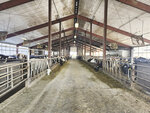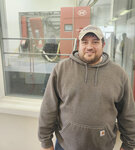

PLATTEVILLE, Wis. — Pioneer Farm, the school dairy for the University of Wisconsin-Platteville, milks cows using two systems. Half of the 200-cow herd is milked in a double-5 herringbone parlor, while the other half is milked in two Lely A5 robotic milking systems.
The dual-herd design offers optimal hands-on learning opportunities for the students, according to the herd manager, Cory Weigel.
“We wanted to give students the opportunity to learn how to milk conventionally and be able to do research in both settings,” Weigel said. “They can do that plus learn how to manage the robots.”
Weigel shared his experience with robots Jan. 31 during a farm tour sponsored by Lely Center Monroe. The cows are housed in one freestall barn, with the robots on one side and the parlor on the other. They are divided into four groups and managed by Weigel with the help of student employees.
When the facility was built in 2006, it was designed to house robots and the parlor. In 2007, two BouMatic robots were installed. The farm used them for three years and then shut them down in 2010. Cows were milked in the parlor until 2021 when the Lely A5 robots were installed.
Weigel said he appreciates the A5 design. The former robots had a force-flow system where cows went through the parlor to get to the feed bunk. The new system is free flow, which gives cows a choice of feeding at the bunk or milking in the robot.
“I didn’t know it would work as well as it has, but it is nice,” Weigel said. “Once the cows figure it out, they come in on their own.”
Students at the university are employed on the farm. Cows are fed once a day with a total mixed ration. The parlor cows and the robot cows are fed different feeds because the robot cows consume a pellet during milking.
Two students are on shift for milking in the parlor twice a day, while one student comes twice a day to check the robot cows. At 6 a.m. and 6 p.m., a student checks the fetch cow list. The student moves those cows into the holding area, cleans the mattress stalls and adds fresh sawdust bedding. The barn is cleaned with automatic scrapers.
Weigel said they typically have 5-6 fetch cows. They are usually fresh cows or cows that have come over from the parlor group to be trained in the robots. The 100-cow robot herd is averaging 3.3 milkings per day and producing about 95 pounds of milk per day per cow. The parlor cows produce slightly less because they are milked just twice per day.
The somatic cell count runs between 180,000-200,000 for both herds, Weigel said. He said there is more management involved on the robot side because the cows are not handled by a human twice a day. The labor is much higher on the parlor side. The student employee chores take up to an hour each shift for the robot herd, while it takes two people up to three hours per shift to milk in the parlor.
Days-in-milk and pregnancy rates are about equal for both herds. The robots are managed with Lely’s Horizon software which pulls data from the cows’ collars. The parlor herd is managed with the SCR collar system.
First-calf heifers are milked in the parlor for the first week after freshening. After that, the cows remain with their peers for the most part. Weigel said if there is a severe case of mastitis, a cow will be moved back to the parlor and treated because it is easier to treat in the parlor than to catch cows in the headlocks. Additionally, if there is a cow that simply will not adapt to the robot for whatever reason, he will move her to the parlor instead of culling her.
“I like having another way to milk the cows that don’t adapt to robots without having to sell them,” Weigel said. “There have been maybe 3-5 cows that didn’t adjust to the robots since we put them in.”
Both herds are on monthly tests. When comparing the results between the DHIA test and the data from the robots, Weigel said it is very close.
The students can learn more about cow behavior with the robots through different studies. They conducted a dry cow study to evaluate the effectiveness of discontinuing the pellet ration in the robot. Some cows stopped visiting the robot within two weeks while one cow continued to try once per day for an entire month.
Future research will involve feed studies using an automatic feeder for one of the groups milked by the robots. Lely makes a stall that feeds pellets without milking. This is another way to measure feed intake and cow behavior. That project is tentatively scheduled to start next month.
Comments
No comments on this item Please log in to comment by clicking here